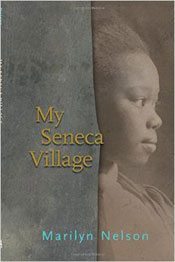by Marsha Qualey
My Seneca Village
by Marilyn Nelson
Namelos, 2015
I’m going to begin with a disclaimer that is also a bit o’ bragging. I’ve had the good fortune to meet and work with Marilyn Nelson (A Wreath for Emmett Till, Snook Alone, How I Discovered Poetry). I’ve stayed up late and sipped wine and talked with her, spent a day escorting her to school visits where she wowed elementary students; she once supped at my table. I also had the good fortune to hear some of the poems in My Seneca Village when the book was a work in progress.
So, obviously I was predisposed to like it. I was not prepared, however, for how quickly and completely I fell in love.
The book opens with Nelson’s “Welcome,” which includes a succinct history of Seneca Village, “Manhattan’s first significant community of African American property owners,” that was founded in 1825. The village was short-lived: “By 1857, everyone would have been forced to move, and Seneca Village would be completely erased by the creation of Central Park.”
41 poems are at the heart of the book. Each was inspired by a name and “identifying label” Nelson found in census records. Presented in chronological order, the poems span thirty-two years; several of the characters reappear, maturing and changing along with the village. For the first reading, it’s beneficial to read the poems in order, even if a quick glance at a table of contents that reveals such titles as “Miracle in the Collection Plate” or “Pig on Ice” tempts you to skip ahead.
Equally important are the one-page scene-setting prose descriptions that preface each poem. Were My Seneca Village ever to be an image-illustrated book, I’d wager not even the finest of our picture book artists could animate the characters and setting as well as the author’s language; it would be akin to breaking a spell.

Historical footnotes accompany several of the poems. Those and the excellent concluding author’s note, in which Nelson explains the poetic forms and rhyming techniques she used, remind the reader that the literary mural unfolding in her hands is the result of history, imagination, and hard and intentional work.
This is a book for all ages, but, oh, what a terrific book to read aloud or simply make available to young readers (though I should warn any interested teacher that there is one poem that might trigger PG-13-ish questions or comments; I won’t mention it by name because I don’t want anyone reading ahead, but it includes the lovely compound noun “pleasure-purveyors”).
Seneca Village is an almost-lost world. With My Seneca Village, Marilyn Nelson brings that world near in time and close to home.


I’m so glad to know about this. I love Marilyn Nelson’s work, and you’ve made it sound like a story that needs to be known.
It’s so exciting to hear that this book is out. I remember being entranced by some of these poems when she read them at a Hamline residency. I walk in Central Park whenever we visit my mother-in-law in NYC so I can’t wait to see and experience the park in a new way, through Marilyn’s book. Off to the bookstore!